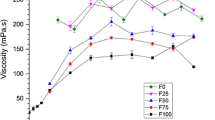Conclusions
The physicomechanical properties of a fibre, particularly its strength, are governed by its structure and by the orientation of the structural elements. Structure formation in precipitation of xanthate from viscose occurs in accordance with the general kinetic laws of phase transitions (formation of supersaturated solutions, formation of centres of the new phase, growth of particles of the new phase according to a linear law (if the substance is in excess) or according to a quadratic law (in the case of diffusion limitation around the centres), formation of oriented structures, and an extremal dependence of the process rate on the temperature).
Increase of the zinc sulphate concentration in the coagulation bath leads to an increase in the number of structure-formation centres. The fibre formed possesses a fine fibrillar structure and good mechanical properties. The capacity of this fibre for orientation stretching depends on the structure of the freshly-formed fibre, the degree of plasticisation, and the temperature of the plasticising medium. In ordinary conditions, viscose fibre is stretched by elastic forced deformation. The authors show that in principle it is possible for freshly-formed fibre to be stretched by plastic flow at 165–170°C in an atmosphere of saturated vapor.
Similar content being viewed by others
Literature cited
A. Sharples, The Crystallisation of Polymers [Russian translation], Izd. Mir (1968), p. 51.
A. Nakai, J. Soc. Text. a. Cell. Ind. Japan, 15, No. 7, 527 (1959).
V. A. Kargin, Z. V. Ukhanova, and N. V. Mikhailov, Scientific Research Work of VNIIV, Gizlegprom (1959); Z. V. Ukhanova, Dissertation, VNIIV (1950).
H. Thiele, K. Plohnke, E. Brandt, and G. Moll, Koll.-Z., 182, 24 (1962).
A. Gröbe, H. J. Purz, K. Maron, and H. Klare, Faserforsch. u. Textilt., 14, No. 9, 347 (1963).
A. T. Serkov, G. I. Kudryavtsev, V. S. Klimenkov, I. N. Kotomina, L. A. Serkova, and N. A. Dorofeev, Vysokomol. Soed., 11B, No. 2 (1969).
O. I. Nachinkin, Khim. Volokna, No. 4, 52 (1969).
Additional information
All-Union Scientific-Research Institute for Synthetic Fibres (VNIIV). Translated from Khimicheskie Volokna, No. 4, pp. 40–45, July–August, 1969.
Rights and permissions
About this article
Cite this article
Serkov, A.T., Kotomina, I.N., Budnitskii, G.A. et al. Production of high-strength cellulose-hydrate fibres. Fibre Chem 1, 409–416 (1970). https://doi.org/10.1007/BF00546567
Issue Date:
DOI: https://doi.org/10.1007/BF00546567




